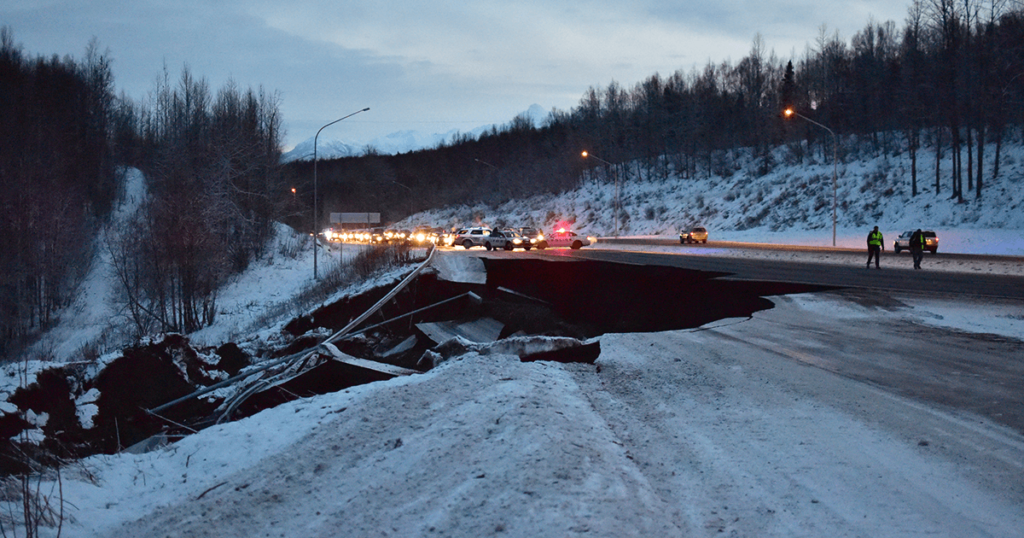
HOMER, ALASKA—I rode out last Friday’s earthquake under the dining room table. My sister-in-law had arrived the night before from Philadelphia for a two-week visit. I made her crouch under the table with me. Her eyes were wide. I wondered: How much longer will this go on?
That is how it always is with earthquakes here in Alaska, where we live along the Ring of Fire, the most seismically active region on the planet. You feel the earth begin to rumble and shake but figure it will stop soon enough, so you just pause and do nothing as the ceiling lamp swings madly above your head. But on Friday, the quake went on and on and on.
Here in Homer, we are about 200 miles south of Anchorage and the epicenter of the magnitude 7.0 temblor. The quake tore into Anchorage and the surrounding areas, rending highways, collapsing houses, and breaking a million different things. Thankfully, no one was killed or seriously injured.
In Homer, the shaking was much less intense. I was sitting at the kitchen counter with coffee cup in hand when the house began to shimmy. I heard a framed picture in the other room fall to the floor. Then it felt as though the house were a boat and we were riding huge swells. The world heaved and swayed.
The shaking lasted so long that a friend had time to shoot a cell phone video tour of his house. The water in his giant fish tank sloshed to the rim. Upside-down wine glasses clanked against each other in their rack. Cupboard doors opened and shut. The quake continued long enough for my husband to send a text from work describing how long it was—which I received and read while the house was still shuddering.
When the tsunami sirens started to blare, I began to feel nervous. Maybe this time there really would be a wave.
Some days, life here is sublime. We fill our freezers with wild salmon each summer. In the winter, our night skies are dark and full of stars. We can walk for hours on wild coastline right from town. We have empty cross-country ski trails a 10-minute drive from our house. I can call a dozen people if my car won’t start and I need someone to pick up my daughters from school. My children are growing up with animal neighbors: moose, porcupine, sea otters, humpback whales.
Other days, life in Alaska, where temperatures are warming twice as fast as in the rest of the nation, feels like one disaster after another. The Cook Inlet salmon run—the commercial fishery that supports many friends and neighbors—looks on the brink of collapse. A recent explosion of European aphids ravaged most of the spruce trees in town. A couple of winters ago, a seabird die-off left local beaches checkerboarded with black and white carcasses so thick you could walk on their feathered bodies for miles. And those cross-country ski trails—well, we wonder if we’ll ever have consistently snowy winters again.
These are just a few of the impacts of warming temperatures we’re feeling in Homer. Farther north, of course, climate change means that sea ice is disappearing, permafrost is melting, and villages—and centuries-old cultural traditions—are eroding away.
No part of life here feels untouched. And we’re barraged by news of what’s to come: moose-killing ticks roving up from the south, wildfire-choked summers, and the souring of our oceans.
State workers have already repaired the roadway near Anchorage where a friend’s now-famous red SUV was marooned on an island of pavement in a sea of earthquake rubble. After a temblor, we can patch, mend, and rebuild. Not so with climate change.
My daughters’ school evacuated to higher ground, so I took the opportunity to drive them and their aunt 20 miles out of town to a patch of public land to cut a Christmas tree. My sister-in-law was a good sport as we waded through shin-deep snow across hummocky ground between spindly spruce, looking for the right tree. We chose one growing in a crowded clump. Cutting this spruce, I told myself to assuage my tree-killing guilt, would make room for the others to grow larger.
As we drove home with the tree strapped to the roof of the car, I caught glimpses of the glaciers on the other side of our bay. The ice glowed blue under a cloudy sky. That ice will probably be gone in a hundred years. Maybe sooner.
Climate change is no sudden quake. It’s a series of transitions and losses. It’s a new normal that constantly shifts. How much longer will this go on? I sometimes wonder, as I look out at the silver-gray water of the bay on which we live. What else will be lost?

